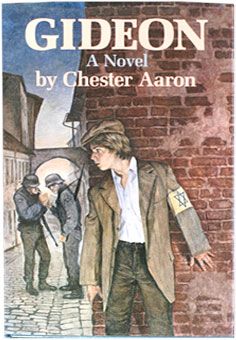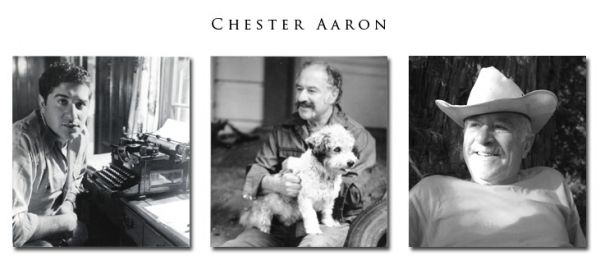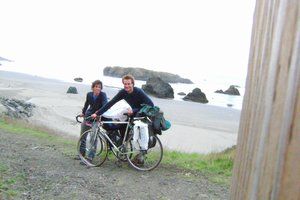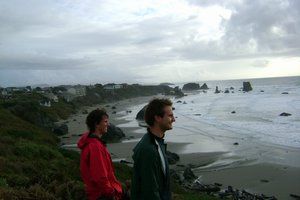 The story of German factory owner Oskar Schindler and the hundreds of Jews he shielded from the Nazis has been a successful novel and an award-winning film. Now his actual history is coming to the Petaluma Museum.
The story of German factory owner Oskar Schindler and the hundreds of Jews he shielded from the Nazis has been a successful novel and an award-winning film. Now his actual history is coming to the Petaluma Museum.
The images below are part of the Leopold Pfeffferberg-Page collection, which he donated to the United States Holocaust Memorial Museum in 1993, explains Senior Historian Peter Black. There is also a summary of Schindler's story, provided by the Museum, at the bottom of this page.
 Oskar Schindler (third from left) at a party with local SS officials on his 34th birthday. Schindler attempted to use his connections with German officials to obtain information that might protect his Jewish employees. Krakow, Poland, April 28, 1942. —Leopold Page Photographic Collection, courtesy of U.S. Holocaust Memorial Museum
Oskar Schindler (third from left) at a party with local SS officials on his 34th birthday. Schindler attempted to use his connections with German officials to obtain information that might protect his Jewish employees. Krakow, Poland, April 28, 1942. —Leopold Page Photographic Collection, courtesy of U.S. Holocaust Memorial Museum
 At Yad Vashem, the Israeli national institution of Holocaust commemoration, Oskar Schindler stands next to the tree planted in honor of his rescue efforts. Jerusalem, Israel, 1970.
At Yad Vashem, the Israeli national institution of Holocaust commemoration, Oskar Schindler stands next to the tree planted in honor of his rescue efforts. Jerusalem, Israel, 1970.
—Leopold Page Photographic Collection, courtesy of U.S. Holocaust Memorial Museum
 Leopold Pfeffferberg was one of the men on Schindler’s famous list, and was also instrumental in interesting writer Thomas Keneally in Schindler’s story. Keneally’s book, originally published as Schindler’s Ark, was a fictionalized account of his story which won the Booker prize in 1982. But Holocaust Museum historian Peter Black points out there is now a formal biography of the man, too.
Leopold Pfeffferberg was one of the men on Schindler’s famous list, and was also instrumental in interesting writer Thomas Keneally in Schindler’s story. Keneally’s book, originally published as Schindler’s Ark, was a fictionalized account of his story which won the Booker prize in 1982. But Holocaust Museum historian Peter Black points out there is now a formal biography of the man, too.
In 1939, the year Germany invaded Poland and launched World War II, Oskar Schindler was living in Moravia, Czechoslovakia, a region with a high ethnic German population. He joined the Nazi party on February 10, 1939. He assumed responsibility for a formerly Jewish-owned factory in Poland and eventually established a second under his ownership. The new factory became a haven for its approximately 900 Jewish workers for much of the war.
Although he amassed a fortune exploiting their labor and trading on the black market, he protected them by insisting they be housed at his factory rather than the local labor camp, Plaszów, which was run by a sadistic SS commandant Amon Leopold Göth. In late summer 1944 as the German war effort was collapsing, Schindler, through negotiations and bribes from his wartime profits, secured permission from German Army and SS officers to move his workers and other endangered Jews to Brünnlitz, near his hometown of Zwittau, where he had been assigned to oversee a new munitions factory. Its workers were placed on “Schindler’s List” and were transported to the factory where they remained in relative safety throughout the remainder of the war.
Asked in 1964 why he had intervened on behalf of the Jews, Schindler replied, “The persecution of the Jews in the General Government in Polish territory gradually worsened in its cruelty. In 1939 and 1940 they were forced to wear the Star of David and were herded together and confined in ghettos. In 1941 and 1942 this unadulterated sadism was fully revealed. And then a thinking man, who had overcome his inner cowardice, simply had to help. There was no other choice.”

Daily Acts, a Petaluma-based dedicated to sustainability and transformation, works, its founder says, by exercising “the freedom to act without having all the answers.”
 As the impacts from Daily Acts ripple outward from the North Bay, founder and Executive Director Trathen Beckman says they are looking for new ways, and new partners, to help expand their influence.
As the impacts from Daily Acts ripple outward from the North Bay, founder and Executive Director Trathen Beckman says they are looking for new ways, and new partners, to help expand their influence.
From conservation to graywater reuse to designing and installing permaculture landscapes, many Daily Acts projects now are focused in one way or another on water. Which, when you think about it, is only natural.
 This was the postcard invitation to the fundraising (and networking) breakfast on Thursday, Nov. 5. Part of the program was a informational video about the organization, created by local filmmaker Eve Goldberg. You can also see it here:
This was the postcard invitation to the fundraising (and networking) breakfast on Thursday, Nov. 5. Part of the program was a informational video about the organization, created by local filmmaker Eve Goldberg. You can also see it here:
[video:http://www.youtube.com/watch?v=T6_BIsoVNOk 300x300]
 There’s nothing like seeing other parts of the world first-hand to give one a different perspective on “home.” A Sonoma State professor who did just that last summer with his students in the international Semester at Sea program, reports back.
There’s nothing like seeing other parts of the world first-hand to give one a different perspective on “home.” A Sonoma State professor who did just that last summer with his students in the international Semester at Sea program, reports back.
The Semester at Sea program offers educational voyages that go completely around the world, and shorter trips, such as the summer voyage in which Rocky Rohwedder participated. Rohwedder, a professor of Environmental Studies, explains how that was structured.
That sequence was set up to ease the touring students into new cultures, by beginning with western European nations that have much in common with the United States. But as they traveled eastward around the Mediterranean, Rohwedder recounts, the changes became more dramatic.

As he traveled, Rocky posted regular blog entries from the trip, with many photographs embedded. In this one, he is seen with his son Ryder, in a public marketplace in Fes, Morocco.

Click here to find out how to apply for a semester at sea.
 Written almost a quarter century ago, Occidental writer Chester Aaron’s novelized account of the Warsaw uprising during World War II is enjoying a second wave of recognition.
Written almost a quarter century ago, Occidental writer Chester Aaron’s novelized account of the Warsaw uprising during World War II is enjoying a second wave of recognition.
Chester Aaron says that when he wrote Gideon, in 1985, as a book for younger readers, he was motivated by a desire in part to overcome their lack of knowledge and understanding of some darker aspects of history that had played out within their parent’s lifetimes,


Even though he has come to terms with the horrors of the war, Aaron says that when he relates his experiences to young students now, they often react angrily.
 Two Iraq war veterans turned peace activists are winding down their cross-country bicycle tour with a visit in Santa Rosa today, one of the last stops in what they’ve dubbed their “Contagious Love Experiment.”
Two Iraq war veterans turned peace activists are winding down their cross-country bicycle tour with a visit in Santa Rosa today, one of the last stops in what they’ve dubbed their “Contagious Love Experiment.”

As a soldier, Conner Curran came to believe that the use of force could be justified if it was used to accomplish something good. But he says being a soldier taught him that belief was not really true.
It’s a bold undertaking, setting out to ride across the country, not knowing people in most of the places you’ll wind up in. But Josh and Conner have made good use of some online resources to help smooth their way.
On their Contagious Love Experience blog, Josh and Conner take turns reflecting on their various day-to-day encounters and experiences. They also detail their personal histories and reasons for what they are doing. This is an except from Josh Siebert's account:
"When I got back from my 14 month deployment to Iraq in April of 08, I planned on taking the money I had been given to kill and destroy my nation’s “enemies” and walking to the military pay headquarters and giving that money back, telling them it wasn’t something I’d participate in anymore and if I had to serve the rest of my enlistment in jail, then that’s where I needed to be.

"Then I learned of conscientious objection, a militarily recognized status that someone’s beliefs has changed so that they are no longer compatible with war. I debated with myself over which option to take. Finally, I figured that as many problems as I had with the system, at least they showed some degree of respect for people’s beliefs, so I would give it a fair shot.
"As I waited until April of 09 for final approval, my plan of spite, of throwing the money back in the government’s face evolved into the walk I’m on now. If I am saying no to war, I want to find out what to say yes to. I want to take a negative and invest it into a positive. In a country where war is preached from the churches, I want to do a little to remember the man who those churches are built for, the man who visited the orphans, served the poor, clothed the naked, fed the hungry… and loved. So that’s what I’ve set out to do and I hope that that love is contagious."
 Josh Steiber and Conner Curran with bring their Contagious Love Experiment to the Sonoma County Peace and Justice Center, 467 Sebastopol Avenue (near Julliard Park) in Santa Rosa, on Tuesday Nov. 3 at 7 pm
Josh Steiber and Conner Curran with bring their Contagious Love Experiment to the Sonoma County Peace and Justice Center, 467 Sebastopol Avenue (near Julliard Park) in Santa Rosa, on Tuesday Nov. 3 at 7 pm
To see where Josh and Conner have been, and where they are headed, view their itinerary here and scroll down to get to the current month. You can also watch this video about their trip.
[video:http://www.youtube.com/watch?v=NxdFNbyrW6Y 400x400]

 Live Radio
Live Radio